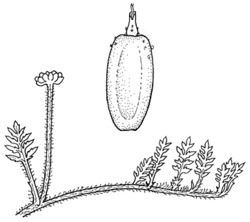Leptinella filicula (Hook.f.) Hook.f. APNI* Synonyms: Cotula filicula (Hook.f.) Benth. APNI*
Cotula filifolia Thunb. APNI*

Description: Stoloniferous perennial herb; branches prostrate, with leaves usually along full length; hairy, sometimes densely so.
Leaves oblong to ovate, pinnatifid with occasional secondary tooth or more usually bipinnatifid; lamina c. 2–5 cm long, 6–15 mm wide, glandular punctate, pinnae ± ovate and acute with ± mucronate apices; petiole slender, c. 10 mm long (occasionally with pinnae running the full length of leaf), stem-clasping.
Heads 6–9 mm diam.; peduncles thick, 1–2 cm long in flower, to 6 c. in fruit; involucral bracts oblong to wide-ovate, obtuse, ± hairy, herbaceous with hyaline margins. Florets sessile; outer 3- or 4-seriate, corolla minute and glandular.
Achenes 1.5–2 mm long, laterally compressed, with thick narrow wing not differentiated from seed, corolla persisting.
Flowering: mainly spring–summer.
Distribution and occurrence: Grows in damp shaded habitats in mountain forest; south from New England N.P.
NSW subdivisions: NC, NT, CT, ST
Other Australian states: Vic. Tas.
Text by E. A. Brown
Taxon concept: Flora of NSW 3 (1992)
APNI* Provides a link to the Australian Plant Name Index (hosted by the Australian National Botanic Gardens) for comprehensive bibliographic data
***The AVH map option provides a detailed interactive Australia wide distribution map drawn from collections held by all major Australian herbaria participating in the Australian Virtual Herbarium project.
|


